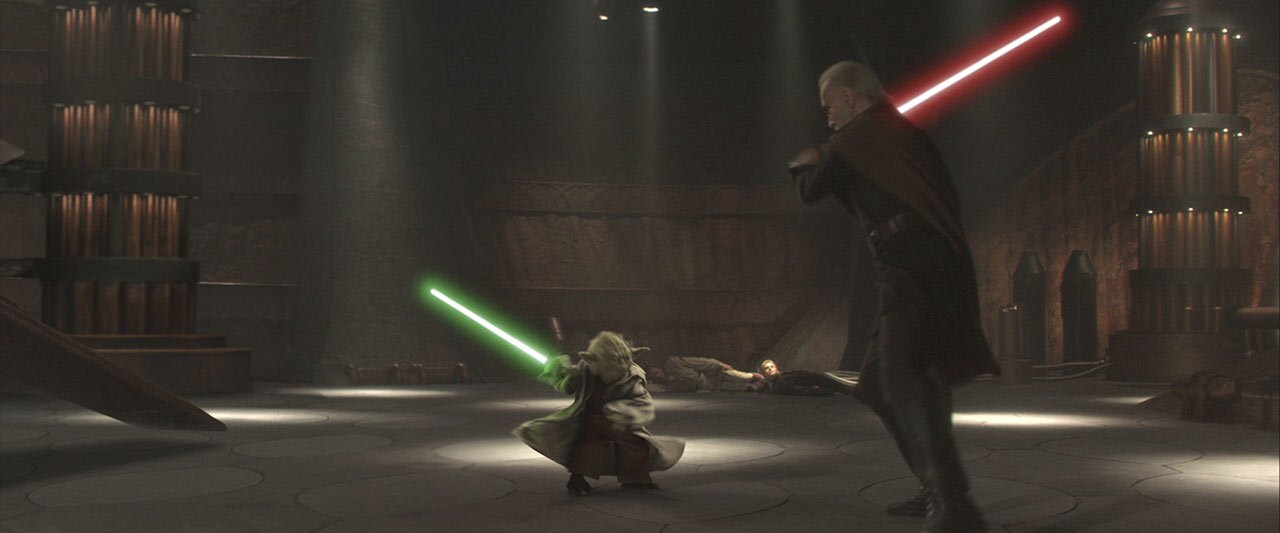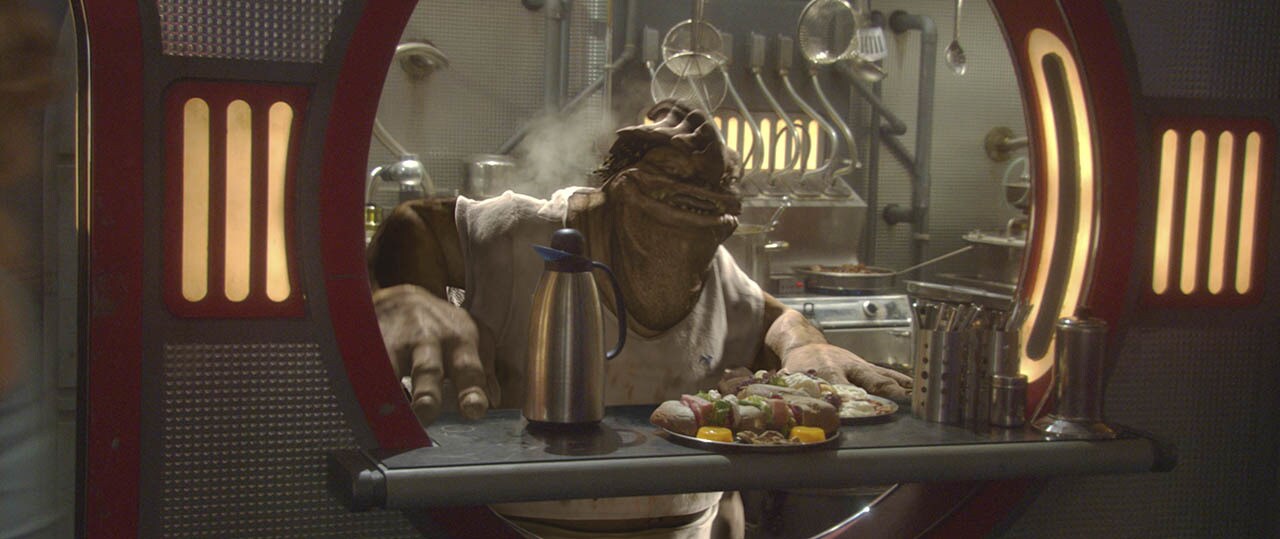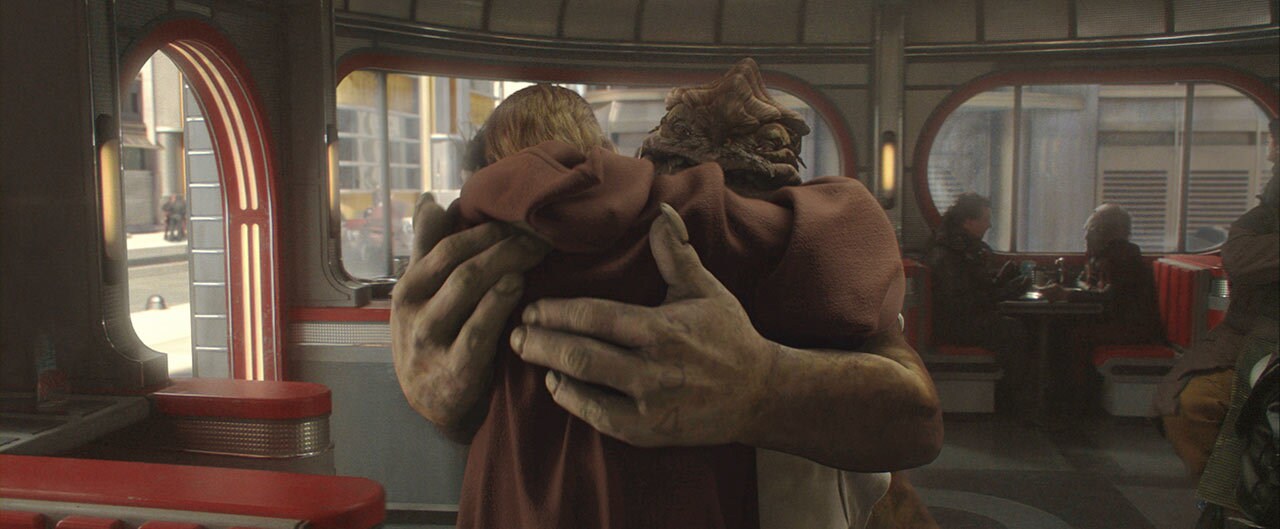The animation director talks to Star Wars.com about the memorable characters, creatures, and sequences of Episode II.
The middle chapter of the prequel trilogy, Star Wars: Attack of the Clones, arrived May 16, 2002. To celebrate the movie’s 20th anniversary, StarWars.com presents Clones at 20, a special series of interviews, editorials, and more.
On July 14, 1999, Rob Coleman attended the London premiere of the first Star Wars prequel, The Phantom Menace, before heading to an after party. As animation director on the film, Coleman led many of its innovations involving digital characters, including early uses of motion-capture for the fully-CG Jar Jar Binks, battle droids, and more. It was years of hard work, but now was a chance to celebrate the release of what was probably the most highly-anticipated movie ever at that point, and a significant leap in visual effects and animation.
Coleman was enjoying the gathering well enough when someone spotted him. “It was huge. There was sort of a VIP section on an upper level, all these security people. [Lucasfilm’s head of publicity] Lynne Hale saw me and she waved, ‘Come on, come on, you can come up here.’ So I went up there and inside was George Lucas, protected by a bunch of rugby players, is what it looked like,” Coleman tells StarWars.com over a Zoom call from Sydney, Australia. “And Lynne said, ‘You know, George would love to talk to you. He has no one to talk to.’ So I said, ‘Of course, I’d love to talk to George!’”
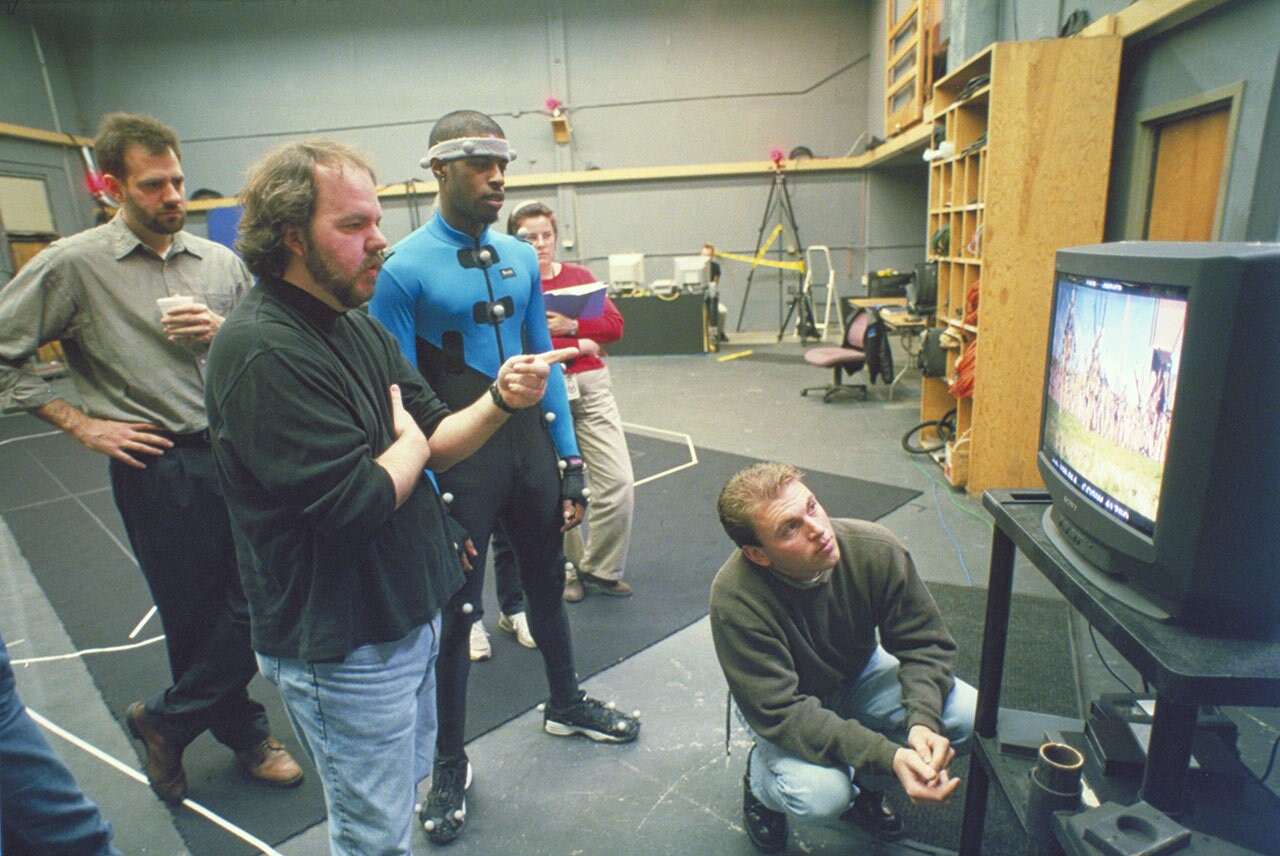
Coleman sat with Lucas, chatting pleasantly about the party. But the Star Wars creator had an ulterior motive. “That's when he leans forward. He said, ‘Well, you'll do the second one with me, right?’” Coleman says. “I'm like, ‘Are you asking right now?’ He said, ‘Yeah.’”
Coleman answered him on the spot.
“‘Well, of course I will! Yes!’”
So began Coleman’s journey on Episode II, which would come to be known as Star Wars: Attack of the Clones. And just like he did with The Phantom Menace, Coleman was determined to make even greater advances in bringing digital characters to life -- including, for the first time entirely in CG, a little green Jedi Master.
“I felt we could take on Yoda”
In the original version of The Phantom Menace, Frank Oz performed Yoda as a puppet, just as he did in the first Star Wars trilogy. But in Episode II, Yoda would need to be a little more agile: in a big creative risk for the movie, he would have to fight. Initially, Lucas told Coleman that the beloved character would again be featured as a puppet, with the animators creating a digital version for his duel with Count Dooku.
Coleman didn’t love this idea.
“I thought, ‘I don't want to be matching to the puppet,’” he says. “I adored the puppet in Empire when I was 16 years old. I mean, I was an audience member watching that thing and absolutely believed in that character. But when it came time to do Attack of the Clones, I felt that it would be really, really difficult, because we would have to match what they did with the puppet and interpret how that puppet movement would be put into a digital character running around. George did say early on in briefing us that we'd see him full-body, he'd have to run and jump and fight. So I did know that, but I thought after learning what we learned on Watto, Jar Jar, and Sebulba [in Episode I], I felt we could take on Yoda.” A digital Yoda, for every scene and every sequence, would be a new goal.
This objective coincided with another secret mission for Coleman. While The Phantom Menace was indeed innovative, Coleman wanted to lead Industrial Light & Magic’s digital animation to even greater heights with Episode II. “Well, from an animation director's point of view, I was proud of what we did on Phantom Menace, but I had already recognized about three quarters of the way through that film that we needed to lift our game in terms of animators acting,” Coleman says. “And for me, that was specifically the non-verbal acting shots. We see them in live-action movies all the time. An editor will cut to a character reacting to, listening to the character who's talking, and as an audience we're very used to seeing that pattern. I felt that there was some resistance from George, and rightly so, that our digital characters were not as rich and not as nuanced as the real people. So I wanted to lift that bar.
“And one of the things I did to pitch the digital Yoda was to do three talking shots and three non-talking shots. It was, ‘Could we sustain that he was alive and thinking and reacting? Could we earn a closeup in Attack of the Clones?’ And we did. You see it early in the movie when the Jedi are in Palpatine's office, surrounded by a bunch of people. Palpatine is saying something, and George, on purpose, cuts to Yoda, and you see Yoda look over his shoulder. And you can tell that he doesn't trust Palpatine. I actually get goosebumps thinking about it. ‘Cause that was -- if I could get us over that high bar, a self-imposed high bar, that meant that we could hold our own. And then because we delivered on that, George gave us more and more and more important acting moments.” The shot was so strong it eventually made it into the teaser trailer.
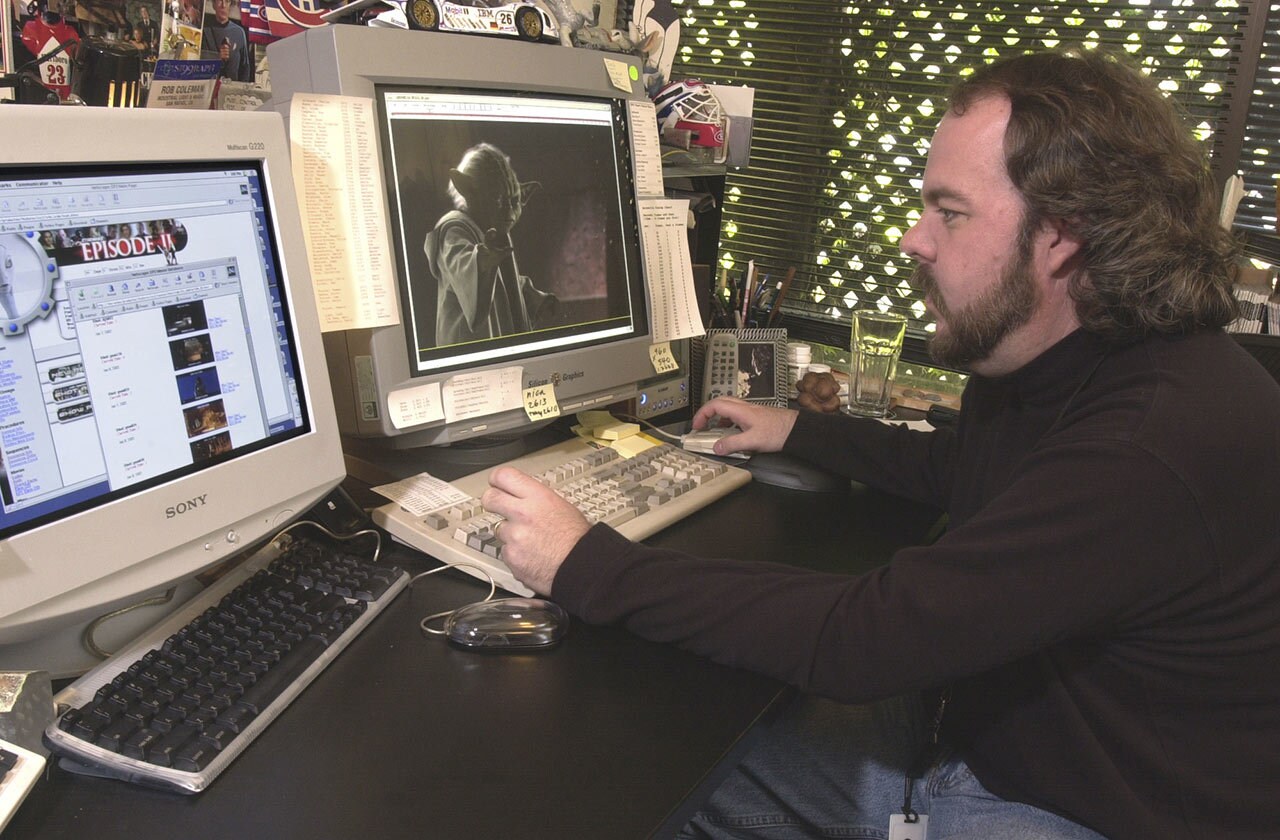
But Coleman didn’t take switching Yoda from puppet to digital lightly, especially coming off the difficult reaction from vocal fans and critics to The Phantom Menace. “I was still stinging from -- I was the guy who helped bring Jar Jar to the screen, and there was all the blow back from that,” he says. “I was probably close to terrified, but I've never been someone to back down from a challenge. Terrified, because I didn't want to be known as the guy who wrecked Yoda. So that was absolutely in the front of my mind. What kept me on target was, I was able to remember what it was like to see Yoda the very first time in 1980, and what I had remembered before I went and studied it was this rich, nuanced performance. When I actually studied it frame by frame, it's actually very limited. But what I wanted -- for us collectively, when building the digital Yoda -- was to honor the range of motion that I thought I'd seen when I was 16.”
Coleman worked with Oz himself to make sure his digital Yoda was as faithful as possible. He came to know exactly what shape Oz’s hand formed inside the puppet’s head, and how that impacted expression. Coleman made sure not to go too far in terms of movement. He even incorporated imperfections that added charm to the original puppet. “Frank, after seeing our initial tests, he was very supportive and said, ‘I love the restraint that you're keeping on this and I love that you're matching what I was doing.’ Like, in terms of the way the head moved. And he was laughing at me, because if you look at the puppet from 1980, every time he turns it, the ears do a little wiggle. I'd read that he didn't like that, that it was the weight of the puppet and holding it above his head, and it just trembles because of his muscles. But when we didn't put that into the digital character, he didn't look old -- it had become a vital part of the character. So we did this too, in the animated digital character, and he just looked the age that he should look. So it was a little step by step. That's how we did it.”
Of course, getting the digital model to work was essential in pulling off Yoda’s climactic lightsaber duel with the secret Sith Lord, Count Dooku. In a movie filled with action set pieces it was the set piece, and one from which the entire feature could collapse if it didn’t look believable. From the start, most of the work would fall to Coleman and his team. “I didn't get the script until a week or two into being here in Sydney. They were building sets and everything. No script, no script, no script. Finally, I got the script, sat down, and my memory of the first draft was, ‘In a fight that defies description, Yoda and Count Dooku battle.’ That was it. That was just one line.” Coleman scheduled a meeting with Lucas about that line, and laughs while recounting what Lucas had to say. “He just said, ‘Yeah, yeah. You gotta figure that out.’”
Coleman first went to stunt coordinator Nick Gillard, who was training with Hayden Christensen, Ewan McGregor, and Christopher Lee. They talked about how someone would fight with smaller weapons, looking at real-world examples. And Jar Jar Binks actor Ahmed Best introduced Coleman to some anime that might help. But Coleman still needed to crack how to depict Yoda’s speed and style in a fight. Luck would strike when he attended a screening of the Jet Li movie Swordsman II at the San Francisco Film Festival. “In that movie there's a nighttime scene in a bamboo forest, and the ninja are leaping from tree to tree, bouncing around,” he says. “And I thought, ‘Ah, all right. There's the inspiration for Yoda to be able to jump around.’”
Once the duel was complete, Coleman tried not to get too excited. “George and I were both pretty happy with it. I was still internally terrified, because my worry was that we had convinced ourselves we had something pretty cool, and I was concerned that we had blinded ourselves and we were gonna be a laughing stock. Because George did want him jumping and leaping and flipping, and I thought some of that might have been a little too cartoony. But George wanted it. So I remember going to the very first paid audience screening on the first day that it came out in San Francisco. I was sitting in the middle of the theater. Nobody knew who I was. I was just sitting there and I remember sliding down in my seat as the scene was coming. I was thinking, ‘This could go really badly.’”
He needn’t have worried.
“Yoda comes around the corner. There's sort of a murmur through the audience. Then you get into the buildup, Dooku’s throwing stuff at him. Then you get the crushing of the lightning. We've seen the lightning just wipe out Obi-Wan and Anakin. And now Yoda is like, just taking it and crushing it [in his hand] and says, ‘Much to learn you still have.’ The audience goes coco. They go crazy!" Coleman says. "Then you get to the shot when he pulls back his duster, which George wanted -- the iconic shot of the gunfighter at the O.K. Corral. So that's the shot of him pushing back his Jedi robes, revealing his lightsaber, and then he uses the Force to put it into his hand. And the audience goes crazy. And then it just kept going, and they were cheering. They were cheering! And I was like, ‘Oh, God. Thank God!’”
The duel remains one of the highlights of the prequel trilogy. But it’s only part of the digital character work found throughout Episode II.
From ‘50s diners to Ray Harryhausen
As animation director, it was Coleman and his team’s job to bring the art department’s designs to life. Over the years, one Episode II character has somewhat surprisingly emerged as a fan favorite: the four-armed Besalisk diner owner, Dexter Jettster. Dex, as he’s known to friends, walks with a limp from his years at the grill; as he breathes, a pouch inflates on his neck; and his belly sticks out from his shirt. In other words, he’s full of character and exciting to watch.
“We had a huge amount of fun bringing him to life,” Coleman says with a smile. “For a lot of the time, for any character, I would ask George -- just when we were sitting, waiting for the lights to be changed on set or whatever -- about backstory, subtext, and inspirations for characters. I always wanted to know whether there was an actor or a character, you know, that George had seen in an old movie, a favorite of his. And with Dexter, it turned out it was Ernest Borgnine, who I always loved as a character actor. So immediately, I had all these images in my head.”
Dex was voiced by Ron Falk, who also acted opposite Ewan McGregor for the scene in which Obi-Wan comes to Dex for some help. Coleman remembers Falk, a theater actor, being “kind of bewildered” by the whole experience, but his performance ended up informing much of what Dex would come to be. “It turns out poor Ron had a sciatic problem down one of his legs, so he had a bit of a limp. He was apologizing for it, and I was like, ‘No, no, no, this is fantastic. This gives your character all kinds of history. This is great,’” Coleman says. “So when you see animated Dexter come out from behind the counter and he's limping, I was just following what Ron did.”
Another clever moment is when Dex gives Obi-Wan a hug, embracing his Jedi friend with three arms -- and pulling his pants up with the fourth. Asked about this moment, Coleman laughs before he starts to speak. “Well, that came about because of his design,” he says. “He had this little butt and this huge body, and I always think of like, plumbers, and they always have their pants sliding down. We just put a little bit of ‘business,’ as I like to call it. It just adds to the character.”
Dex wasn’t the only new other-worldly being in Attack of the Clones, however. Coleman helped create a few more, and they were far less friendly.
As Attack of the Clones gears up for a grand ending that ultimately sees the start of the Clone Wars, our heroes are sentenced to death -- by movie monster. Anakin, Obi-Wan, and Padmé must face three creatures: the acklay, a huge, crab-meets-Praying Mantis terror; the reek, a bull-like animal with a temper; and the nexu, which looks like a big cat crossed with a rat and a spider. It plays like a lost sequence from stop-motion innovator Ray Harryhausen, and that was intentional.
“One of my favorite movies as a kid was Mysterious Island, where you have that huge crab on the beach fighting the humans. When there was an opportunity to have Obi-Wan in profile fighting the acklay, I was set, ‘Okay, that has to be that shot from Mysterious Island. We have to do that.’ But I certainly went and rewatched a bunch of Ray's work at that time to try and get a sense of the style of motion. We weren't trying to make it look like stop-motion puppet animation, but we wanted to pay tribute to a man who had [a big influence on us]. Ray came to ILM two times when I was there and we had a special reception for him up at Skywalker [Ranch]. George was a big fan, Dennis Muren was a huge fan. All of us were fanboying when Ray showed up, and I got to have Ray in my office for a while and talk him through what we were doing. That was a true highlight for me. So yeah, that was on purpose from George all the way down. We all were like, ‘Yes, yes, yes, yes, yes. This has to be a throwback to Ray.’”
While there’s lots to love about each of these monstrosities that Coleman helped bring to the world, he does have a favorite.
“Yeah, probably the acklay," he says. "I loved the design of that character, the way we could move it on those six legs, the way that it attacked. It was the most interesting of them.”
And then there are the titular clones. While thousands appear in the film, there wasn’t a single set of armor that was actually built and worn by an actor. Every clone was performed via motion-capture, and digitally created by Coleman and his crew.
“My memory was, it was George,” Coleman says. “He just threw the gauntlet down and said, ‘No real guys in costumes.’ And I don't know why. I think part of it was just to give us a high bar to go over. I think, probably, it was a cost thing too. Like, how many costumes would they make and how many extras would they have? And the reality of the extras wouldn't be all exactly the same height and proportions, and the whole idea was this is a clone army. So they're all the same.”
Coleman recalls attending a convention and being approached by fans, eagerly asking him who was lucky enough to be inside the armor. Their excitement turned to shock when he revealed that there was no armor.
“I was happy with them,” Coleman says of the animated clones. “And the fact that the fans didn’t know, that’s the real test.” Considering that Coleman received an Academy Award nomination for his work on Attack of the Clones, it’s safe to say he double passed.

20 years of Clones
Following Attack of the Clones, Coleman finished his work on the prequel trilogy with Episode III. He then moved onto Lucasfilm Animation in 2005, helping launch both the studio and the beloved Star Wars: The Clone Wars animated series, even directing several early episodes. Coleman then left Lucasfilm, serving as an animation director at Dr. D. Studios on Happy Feet Two, and as head of animation at Animal Logic, with credits including The LEGO Movie, The LEGO Batman Movie, and Peter Rabbit.
But as is often the case with Star Wars, the circle is now complete: Coleman returned to ILM in September 2021 as a key creative for feature animation at the company’s Sydney location. And as Attack of the Clones turns 20, Coleman looks back on the movie’s accomplishments with a sense of gratification.
“Well, I'm incredibly proud. It's a strange thing, because I know I was there and my name's in the credits and I remember so many things, but it almost feels like a different lifetime ago. Almost a different me. It was a different me, because I have 20 more years of experience under my belt. I count myself incredibly fortunate to have been at ILM during those times and to go from Episode I to II to III.
“In terms of that show, I’m extremely proud of the work that we did as an animation group. Obviously, the Yoda fight, I think, will be the thing that I will connect with forever as a truly high moment in my career. Because of how precious that character was to all of us who saw him for the first time in 1980 and to think of my 16-year-old self, and then however old I was 20 years ago -- I would've been 37, which is amazing to think -- being able to help bring George's beloved character to the screen and make him fully digital and having him as an acting, emoting, thinking character, I'm very happy. And I've met so many people over the years of varying ages when they saw it, and it resonates with so many people that I'm thrilled that I got to be in an important role on that film.”












